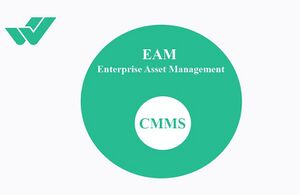What Is A CMMS?
The acronym CMMS stands for Computerized Maintenance Management System. This software package was designed to manage maintenance practices globally, on a strategic, financial, and operational level. It is today the essential software of the industrial sector. Much more than simple computer programming, it is an assistant for maintenance teams, the cornerstone of industrial efficiency.
Because you can use it to achieve different goals, there are different ways to describe computerized maintenance management software. On the one hand, it is sophisticated software that captures and uses thousands of data points to provide an overview of how a facility is operating or detailed information about individual pieces of equipment. In terms of functionality, CMMS software offers businesses the ability to monitor inventory levels, manage work orders, set up and schedule preventive maintenance programs, and quickly generate accurate reports. But on another level, it’s just the solution maintenance managers need. Automating processes and streamlining workflows makes your life less stressful by making your workday more predictable.
A CMMS essentially serves as the central hub for maintenance and reliability programs, acting as a repository for crucial data. Maintenance teams leverage CMMS software to oversee their work and gain insights into machine health and reliability, making it particularly well-suited for managing industrial facilities where machine assets are critical for production.
CMMS software is instrumental in enhancing the utilization, availability, and longevity of various assets, including equipment, machinery, fleets, infrastructures, facilities, or operations.
Modern CMMS solutions are typically cloud-based and offer cutting-edge features such as mobile CMMS applications, tools for regulatory compliance, and the ability to operate across multiple sites or languages. They can also seamlessly integrate with other applications, like ERP purchasing software, or access isolated production data from systems such as SCADA, PLC, and BMS. Leading CMMS platforms can even connect with condition monitoring sensors and software, thereby enabling predictive maintenance.
The terms CMMS system, solution, platform, and software are interchangeable, all referring to digital systems for effective maintenance management.
By adopting CMMS software, organizations can save time, simplify their work processes, prevent downtime, reduce maintenance costs, and bolster the reliability of their assets.
Advantages of CMMS software
CMMS software offers numerous advantages for maintenance and reliability teams looking to save time, enhance efficiency, maximize uptime, and strengthen reliability. Integrating CMMS software doesn’t simply digitize maintenance management; when utilized effectively, it can significantly improve core Key Performance Indicators (KPIs), reduce maintenance costs, and boost production. In the era of AI, IIoT, and smart factories, having such software is an essential tool for streamlining and managing your maintenance team.
Here are some of the key advantages that maintenance programs using CMMS software have over the competition:
- Reduce downtime with preventive and predictive maintenance.
- Save time on management, organization, scheduling, data entry, and reporting.
- Increase overall reliability and extend equipment lifespan with asset management, tracking, and analysis.
- Ensure compliance with regulatory and safety standards through maintenance standardization across teams and worksites.
- Boost work order completion rates with efficient work order management.
- Track and reduce maintenance costs through integration with purchasing software.
- Monitor and enhance productivity while reducing labor costs through work order scheduling.
- Simplify reporting by tracking Key Performance Indicators (KPIs) and providing user-friendly reports and dashboards.
Top 10 Industries That Benefit The Most from CMMS
Several industries use different types of CMMS to help them streamline their operations. According to a 2020 Plant Engineering study, 29% of participants say their management is preparing to carry out predictive maintenance systems soon.
Here are the top 10 Industries That Benefit The Most from CMMS.
- Energy Industry
- Manufacturing Industry
- Construction Industry
- Facilities Industry
- Healthcare Industry
- Warehousing and Distribution Industry
- Education Industry
- Oil and Gas Industry
- The Mining Industry
- Farming and Agriculture Industry
Benefits of CMMS software
CMMS software can provide a wide range of benefits to business owners, including:
CMMS software performs a range of functions to enhance maintenance management. It acts as work order software, tracking maintenance orders and scheduling tasks, which is pivotal for maintenance teams in managing their workflows and reducing downtime. Furthermore, through seamless integrations with tools such as vibration sensors and condition monitoring devices, CMMS allows continuous monitoring of machine health and conditions, facilitating the implementation of condition-based maintenance strategies.
CMMS tools have huge potential to improve the efficiency and profitability of businesses. With their ability to store data, track maintenance, schedule tasks, and forecast costs, they can save time and money and help ensure better outcomes for customers.
Business owners should take advantage of these powerful tools to bring more success and prosperity to their operations. Ultimately, investing in a reliable CMMS tool will be an investment that pays off for many years to come.


